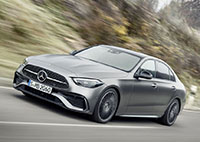
It’s finally the C’s time to shine. As part of a thorough fifth-generation C-Class redesign, the new model will bypass first-gen MBUX electronics to be second in the lineup to feature Mercedes’ entirely new separated digital gauge cluster display and infotainment touchscreen.
That’s probably the biggest 2022 C-Class news, next to the updated model’s completely new sheet metal, mostly because the latter could’ve easily been guessed by looking at the recently updated fourth-generation A-Class sedan that debuted in 2018.

The new (W206) C-Class is the A’s obvious bigger brother, at least when the two model’s sedans are placed side-by-side. The A can be had in a sporty hatch as well, while the C is offered in coupe, convertible and wagon body styles. We’ve only seen the sedan and wagon thus far, and sadly the latter car won’t make the journey across the Atlantic later this year, news that no doubt has fans of low-slung, elongated five-door Mercs feeling woeful.
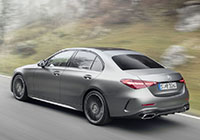
At least the new C four-door should put a smile on those who prefer keeping their cargo snuggly secured away in a locked trunk, as it’s one very stylish sedan. It boasts Mercedes’ new frowning oval grille (the previous sport grille was turned up at its ends, resulting in a happier countenance), also seen on the just-noted A-Class, plus the leaner looking CLA. Moving outward, a new set of more sharply angled Performance LED headlamps stretch farther around each front fender, while a reworked lower front fascia comes across cleaner for a more minimalist approach. Additionally, the hood incorporates a pair of sinuous character lines, pulling memories of the ‘50s-era 300 SL, which is certainly no bad thing.
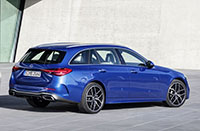
Peering down each side, Mercedes abandoned the outgoing C sedan’s gracefully penned beltline crease, which used to sweep downward through the rear door ahead of disappearing under its handle. This said, the new model appears more slab-sided, although the lower crease remains, which kicks upward as it moves rearward.
Quite possibly the most obvious differentiator between old and new Cs are the taillights, the latest iteration featuring two-piece triangular lenses that wrap horizontally around the rear flanks, compared to the outgoing model’s less distinctive ovoid lamps. Look no further than the A-Class sedan for their inspiration. Finally, the new C-Class gets fresh sets of 18- and 19-inch alloys, along with a revised palette of exterior paint colours.
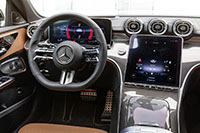
Those lured to a new car via modernized electronics may have already flocked to Mercedes in recent years, being that the brand’s two-in-one MBUX driving/infotainment display has been second to none (except for Hyundai/Kia that adopted a similar design for many of their latest models). As noted earlier, Mercedes is skipping over the initial MBUX system for an altogether different approach to design and functionality. Instead, it will keep a similar fixed tablet-style display for the car’s primary gauge cluster, but will host the majority of infotainment info on a much larger individual display in a more conventional location, a bit lower on the centre stack, which should be easier to reach for some drivers. Anyone moving from the current C’s analogue dial and digital multi-information setup to the new all-electronic layout shouldn’t be put off, but some elevating their lifestyle from an A-Class may be chagrined after getting used to the first-gen MBUX design. Then again, if new design is good enough for Merc’s full-size S-Class flagship, it should be acceptable for C-Class users, the smaller sedan being the second car in the Stuttgart-brand’s lineup to complete rework its entire instrument panel layout.

The centre display is an elegantly crafted bit of electronica, particularly how it appears to seamlessly meld into a high-gloss carbon fibre weave surface treatment as it curves into the lower console, save for a thin strip of bisecting analogue buttons. The larger display is a touchscreen, just like the outgoing C’s smaller monitor and Merc’s first-gen MBUX unit, the extra digital acreage necessary now that a console-mounted touchpad is nowhere to be seen. Fans of minimalism will like how it looks, but others who preferred a best-of-both-worlds approach will probably complain.
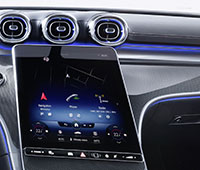
According to Mercedes, the new display integrates haptic feedback for more fingertip feedback, while updating the system software now takes place over-the-air. Mercedes has included mention biometric authentication too, via either voice command or fingerprint scanning, while touching the scanner will initiate pre-selected memory adjustments to the driver seat, radio station, etcetera. The ability to purchase apps (and no doubt additional items in the future) from the Mercedes Me store can be done via fingerprint scanning too, while the C’s new head-up display utilizes augmented reality to project real-time visuals on the windshield in front of the driver.
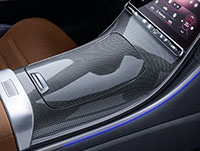
Not only the driver benefits from new C’s improvements, by the way. Everyone aboard should appreciate the added comfort from its increase width and length. Both front and rear passengers should have more space for their legs and shoulders at their disposal, which is critical in a category that includes a few rivals boasting almost mid-size dimensions.
For those put off by the larger car when parking, a rear-wheel steering system should make the process easier. Additionally, the C 300 4Matic model gets some major tech upgrades under the hood, such as a standard 48-volt integrated starter-generator (ISG), a.k.a. a mild hybrid drive system. It combines with Mercedes’ potent 2.0-litre four-cylinder engine and nine-speed automatic transmission, for a total of 255 horsepower and 295 lb-ft of torque. The electric motor is responsible for 20 of those horses, plus 147 lb-ft of additional twist, but despite its boost in output the new car is a tad slower than the outgoing model off the line. Of course, the changes are more about fuel-efficiency, the hybrid drivetrain joined by driveline drag reducing gliding capability, plus a kinetic energy recovery system.
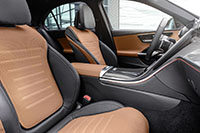
Strangely, we won’t see the plug-in hybrid version, which reportedly has an EV range of 100 km between charges (maybe it’s reserved for Germany’s taxi fleets), so any hopes of scoring any front-of-business reserved plug-in parking spots when at the wheel of a C-Class need to be dashed, or for that matter blasting past rush-hour traffic in the HOV lane.
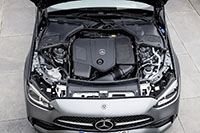
Mercedes has made no announcements of ultra-potent six- or eight-cylinder AMG-tuned C-Class models either, but instead we’re hearing reports of electrically-assisted four-cylinder variants, possibly similar to Volvo’s T8 and Polestar Engineered power units. The difference between regular and AMG hybrid Cs will come down to tuning, with the former prioritizing fuel economy and the latter focused on performance.
Of course, the new C-Class will also include all the expected driver assistive systems, including sign and red-light recognition, and steering assistance to help drivers maintain a chosen lane up to 210 km/h, where legally permitted.

As noted earlier, we can expect the new 2022 C 300 4Matic arrive in Canadian dealerships later this year, but we’ll have to wait a little longer for pricing and trim details. For the time being, Mercedes is providing up to $5,500 in additional incentives on the 2021 C-Class models, while CarCostCanada members are currently saving an average of $3,950.
To learn more about how to save money with your CarCostCanada membership, check out our “How it Works” page. Members receive info about manufacturer leasing and financing deals when available, plus factory rebates when available, as well as dealer invoice pricing that can help you save thousands when negotiating over a new vehicle. Also, be sure to download the our free app from the Google Play store or Apple store too, so you can access all this critical money-saving info on your smartphone.
The C-Class: Rapid-Fire Questions to Dirk Fetzer (1:07):
The New C-Class Sedan: An Intelligent Comfort Zone (0:49):
The New C-Class Sedan: A Connected Comfort Zone (0:56):
Story credits: Trevor Hofmann
Photo credits: Mercedes-Benz
